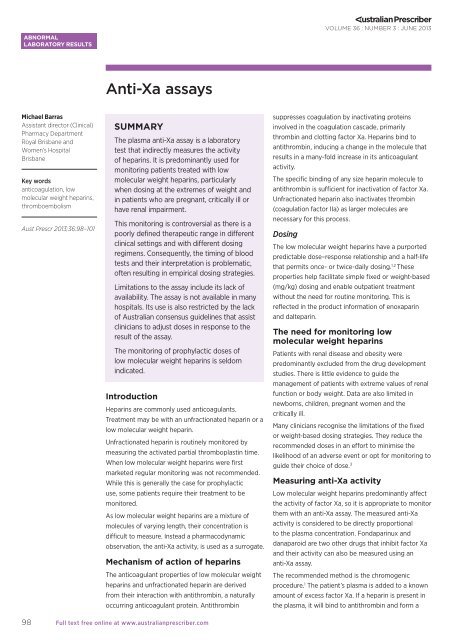download the full PDF issue - Australian Prescriber
download the full PDF issue - Australian Prescriber
download the full PDF issue - Australian Prescriber
Create successful ePaper yourself
Turn your PDF publications into a flip-book with our unique Google optimized e-Paper software.
ABNORMAL<br />
LABORATORY RESULTS<br />
VOLUME 36 : NUMBER 3 : JUNE 2013<br />
Anti-Xa assays<br />
Michael Barras<br />
Assistant director (Clinical)<br />
Pharmacy Department<br />
Royal Brisbane and<br />
Women’s Hospital<br />
Brisbane<br />
Key words<br />
anticoagulation, low<br />
molecular weight heparins,<br />
thromboembolism<br />
Aust Prescr 2013;36:98–101<br />
SUMMARY<br />
The plasma anti-Xa assay is a laboratory<br />
test that indirectly measures <strong>the</strong> activity<br />
of heparins. It is predominantly used for<br />
monitoring patients treated with low<br />
molecular weight heparins, particularly<br />
when dosing at <strong>the</strong> extremes of weight and<br />
in patients who are pregnant, critically ill or<br />
have renal impairment.<br />
This monitoring is controversial as <strong>the</strong>re is a<br />
poorly defined <strong>the</strong>rapeutic range in different<br />
clinical settings and with different dosing<br />
regimens. Consequently, <strong>the</strong> timing of blood<br />
tests and <strong>the</strong>ir interpretation is problematic,<br />
often resulting in empirical dosing strategies.<br />
Limitations to <strong>the</strong> assay include its lack of<br />
availability. The assay is not available in many<br />
hospitals. Its use is also restricted by <strong>the</strong> lack<br />
of <strong>Australian</strong> consensus guidelines that assist<br />
clinicians to adjust doses in response to <strong>the</strong><br />
result of <strong>the</strong> assay.<br />
The monitoring of prophylactic doses of<br />
low molecular weight heparins is seldom<br />
indicated.<br />
Introduction<br />
Heparins are commonly used anticoagulants.<br />
Treatment may be with an unfractionated heparin or a<br />
low molecular weight heparin.<br />
Unfractionated heparin is routinely monitored by<br />
measuring <strong>the</strong> activated partial thromboplastin time.<br />
When low molecular weight heparins were first<br />
marketed regular monitoring was not recommended.<br />
While this is generally <strong>the</strong> case for prophylactic<br />
use, some patients require <strong>the</strong>ir treatment to be<br />
monitored.<br />
As low molecular weight heparins are a mixture of<br />
molecules of varying length, <strong>the</strong>ir concentration is<br />
difficult to measure. Instead a pharmacodynamic<br />
observation, <strong>the</strong> anti-Xa activity, is used as a surrogate.<br />
Mechanism of action of heparins<br />
The anticoagulant properties of low molecular weight<br />
heparins and unfractionated heparin are derived<br />
from <strong>the</strong>ir interaction with antithrombin, a naturally<br />
occurring anticoagulant protein. Antithrombin<br />
suppresses coagulation by inactivating proteins<br />
involved in <strong>the</strong> coagulation cascade, primarily<br />
thrombin and clotting factor Xa. Heparins bind to<br />
antithrombin, inducing a change in <strong>the</strong> molecule that<br />
results in a many-fold increase in its anticoagulant<br />
activity.<br />
The specific binding of any size heparin molecule to<br />
antithrombin is sufficient for inactivation of factor Xa.<br />
Unfractionated heparin also inactivates thrombin<br />
(coagulation factor IIa) as larger molecules are<br />
necessary for this process.<br />
Dosing<br />
The low molecular weight heparins have a purported<br />
predictable dose–response relationship and a half-life<br />
that permits once- or twice-daily dosing. 1,2 These<br />
properties help facilitate simple fixed or weight-based<br />
(mg/kg) dosing and enable outpatient treatment<br />
without <strong>the</strong> need for routine monitoring. This is<br />
reflected in <strong>the</strong> product information of enoxaparin<br />
and dalteparin.<br />
The need for monitoring low<br />
molecular weight heparins<br />
Patients with renal disease and obesity were<br />
predominantly excluded from <strong>the</strong> drug development<br />
studies. There is little evidence to guide <strong>the</strong><br />
management of patients with extreme values of renal<br />
function or body weight. Data are also limited in<br />
newborns, children, pregnant women and <strong>the</strong><br />
critically ill.<br />
Many clinicians recognise <strong>the</strong> limitations of <strong>the</strong> fixed<br />
or weight-based dosing strategies. They reduce <strong>the</strong><br />
recommended doses in an effort to minimise <strong>the</strong><br />
likelihood of an adverse event or opt for monitoring to<br />
guide <strong>the</strong>ir choice of dose. 3<br />
Measuring anti-Xa activity<br />
Low molecular weight heparins predominantly affect<br />
<strong>the</strong> activity of factor Xa, so it is appropriate to monitor<br />
<strong>the</strong>m with an anti-Xa assay. The measured anti-Xa<br />
activity is considered to be directly proportional<br />
to <strong>the</strong> plasma concentration. Fondaparinux and<br />
danaparoid are two o<strong>the</strong>r drugs that inhibit factor Xa<br />
and <strong>the</strong>ir activity can also be measured using an<br />
anti-Xa assay.<br />
The recommended method is <strong>the</strong> chromogenic<br />
procedure. 1 The patient’s plasma is added to a known<br />
amount of excess factor Xa. If a heparin is present in<br />
<strong>the</strong> plasma, it will bind to antithrombin and form a<br />
98<br />
Full text free online at www.australianprescriber.com
















